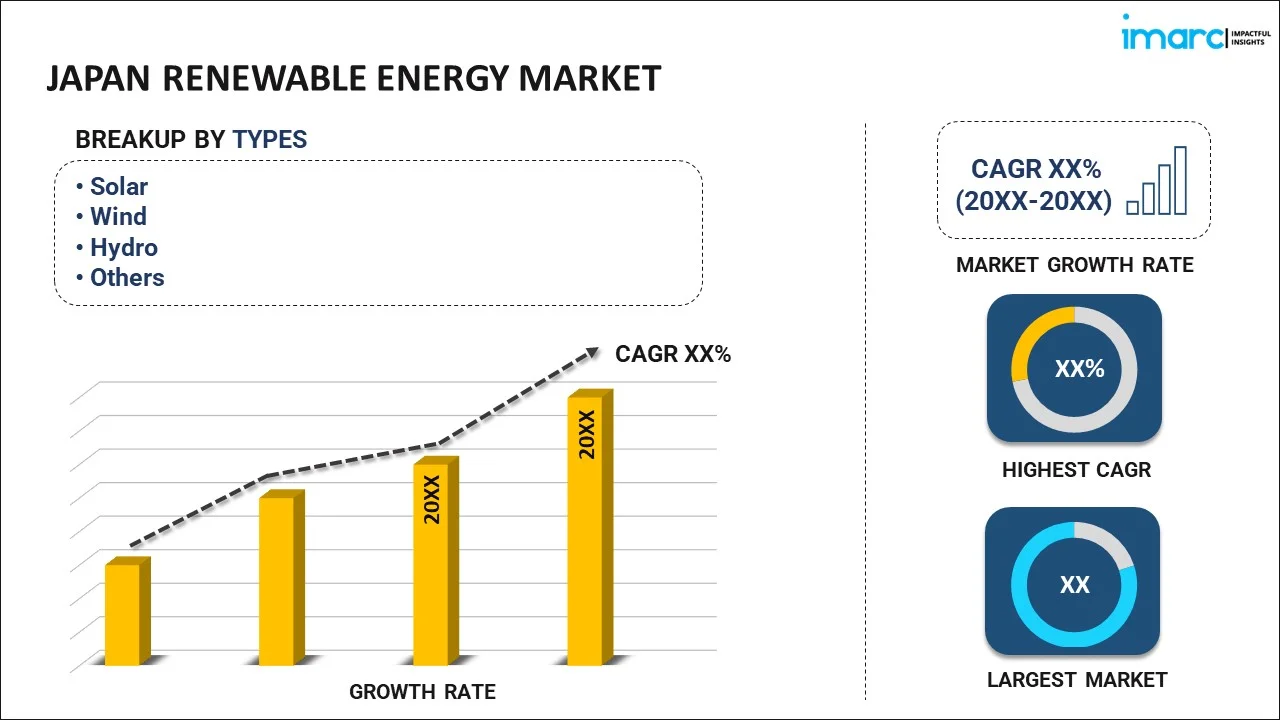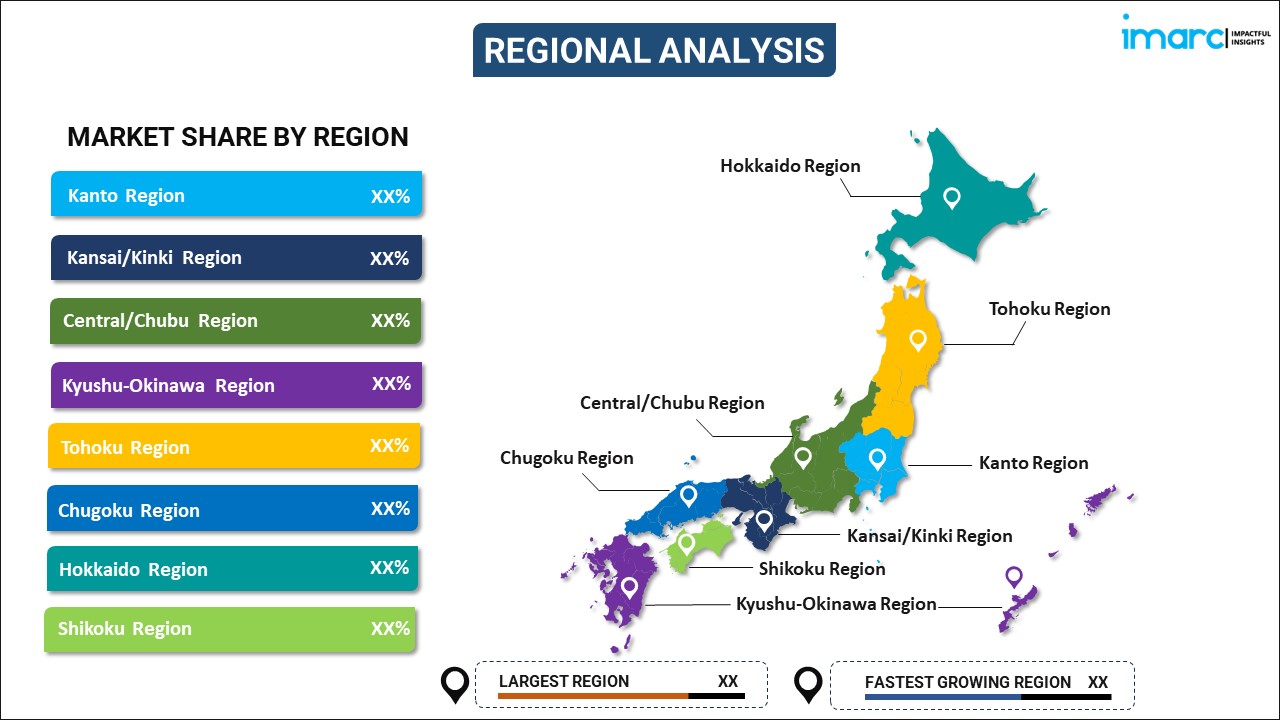
Japan Renewable Energy Market Report by Type (Solar, Wind, Hydro, Bioenergy, and Others), and Region 2025-2033
Market Overview:
Japan renewable energy market size reached 247.2 TWh in 2024. Looking forward, IMARC Group expects the market to reach 355.0 TWh by 2033, exhibiting a growth rate (CAGR) of 3.90% during 2025-2033. The ongoing advancements in renewable energy technologies, which have led to increased efficiency and reduced costs, making renewable energy more competitive with fossil fuels are primarily driving the market.
|
Report Attribute
|
Key Statistics
|
|---|---|
|
Base Year
|
2024 |
|
Forecast Years
|
2025-2033 |
|
Historical Years
|
2019-2024
|
| Market Size in 2024 | 247.2 TWh |
| Market Forecast in 2033 | 355.0 TWh |
| Market Growth Rate (2025-2033) | 3.90% |
Renewable energy is a type of power produced from naturally replenishing resources, such as rain, sunlight, wind, tides, waves, and geothermal heat. Unlike finite fossil fuels like coal, natural gas, and oil, renewable energy sources are sustainable and have minimal environmental impact. Solar energy harnesses the sun's radiation through photovoltaic cells or solar thermal systems to generate electricity and heat water. Wind power uses turbines to convert wind energy into electricity. Hydropower utilizes the gravitational force of flowing or falling water to generate electricity. Geothermal energy taps into the Earth's internal heat for heating, cooling, and electricity production. Biomass energy derives from organic materials like wood, crop residues, and organic waste, which can be burned or converted into biofuels. Renewable energy is important for decreasing greenhouse gas emissions, mitigating climate change, and promoting energy independence. It offers long-term sustainability, job creation, and the potential for decentralized energy production, making it a vital component of a cleaner and more sustainable energy future.
Japan Renewable Energy Market Trends:
The renewable energy market in Japan is experiencing remarkable growth due to a confluence of factors. Firstly, environmental concerns have taken center stage, prompting governments in Japan to prioritize sustainable energy sources. Consequently, stringent regulations and emissions targets have created a favorable policy landscape for renewable energy development. Moreover, technological advancements have played a pivotal role in driving this market forward. Breakthroughs in solar panel efficiency, wind turbine design, and energy storage solutions have made renewable sources increasingly competitive with fossil fuels. Furthermore, the falling costs associated with renewable energy technologies have significantly bolstered their adoption. As economies of scale and increased manufacturing efficiency have taken hold, the price of renewable energy production has become increasingly affordable, attracting a wider range of investors and consumers. Additionally, energy security concerns, which have spurred interest in diversifying energy sources, reducing reliance on fossil fuels, and ensuring a stable and sustainable energy supply, are expected to drive the market in Japan.
Japan Renewable Energy Market Segmentation:
IMARC Group provides an analysis of the key trends in each segment of the market, along with forecasts at the country level for 2025-2033. Our report has categorized the market based on type.
Type Insights:

- Solar
- Wind
- Hydro
- Bioenergy
- Others
The report has provided a detailed breakup and analysis of the market based on the type. This includes solar, wind, hydro, bioenergy, and others.
Regional Insights:

- Kanto Region
- Kansai/Kinki Region
- Central/ Chubu Region
- Kyushu-Okinawa Region
- Tohoku Region
- Chugoku Region
- Hokkaido Region
- Shikoku Region
The report has also provided a comprehensive analysis of all the major regional markets, which include Kanto Region, Kansai/Kinki Region, Central/ Chubu Region, Kyushu-Okinawa Region, Tohoku Region, Chugoku Region, Hokkaido Region, and Shikoku Region.
Competitive Landscape:
The market research report has also provided a comprehensive analysis of the competitive landscape in the market. Competitive analysis such as market structure, key player positioning, top winning strategies, competitive dashboard, and company evaluation quadrant has been covered in the report. Also, detailed profiles of all major companies have been provided.
Japan Renewable Energy Market Report Coverage:
| Report Features | Details |
|---|---|
| Base Year of the Analysis | 2024 |
| Historical Period | 2019-2024 |
| Forecast Period | 2025-2033 |
| Units | TWh |
| Scope of the Report | Exploration of Historical and Forecast Trends, Industry Catalysts and Challenges, Segment-Wise Historical and Predictive Market Assessment:
|
| Types Covered | Solar, Wind, Hydro, Bioenergy, Others |
| Regions Covered | Kanto Region, Kansai/Kinki Region, Central/ Chubu Region, Kyushu-Okinawa Region, Tohoku Region, Chugoku Region, Hokkaido Region, Shikoku Region |
| Customization Scope | 10% Free Customization |
| Post-Sale Analyst Support | 10-12 Weeks |
| Delivery Format | PDF and Excel through Email (We can also provide the editable version of the report in PPT/Word format on special request) |
Key Questions Answered in This Report:
- How has the Japan renewable energy market performed so far and how will it perform in the coming years?
- What has been the impact of COVID-19 on the Japan renewable energy market?
- What is the breakup of the Japan renewable energy market on the basis of type?
- What are the various stages in the value chain of the Japan renewable energy market?
- What are the key driving factors and challenges in the Japan renewable energy?
- What is the structure of the Japan renewable energy market and who are the key players?
- What is the degree of competition in the Japan renewable energy market?
Key Benefits for Stakeholders:
- IMARC’s industry report offers a comprehensive quantitative analysis of various market segments, historical and current market trends, market forecasts, and dynamics of the Japan renewable energy market from 2019-2033.
- The research report provides the latest information on the market drivers, challenges, and opportunities in the Japan renewable energy market.
- Porter's five forces analysis assist stakeholders in assessing the impact of new entrants, competitive rivalry, supplier power, buyer power, and the threat of substitution. It helps stakeholders to analyze the level of competition within the Japan renewable energy industry and its attractiveness.
- Competitive landscape allows stakeholders to understand their competitive environment and provides an insight into the current positions of key players in the market.
Need more help?
- Speak to our experienced analysts for insights on the current market scenarios.
- Include additional segments and countries to customize the report as per your requirement.
- Gain an unparalleled competitive advantage in your domain by understanding how to utilize the report and positively impacting your operations and revenue.
- For further assistance, please connect with our analysts.
 Inquire Before Buying
Inquire Before Buying
 Speak to an Analyst
Speak to an Analyst
 Request Brochure
Request Brochure
 Request Customization
Request Customization




.webp)




.webp)












